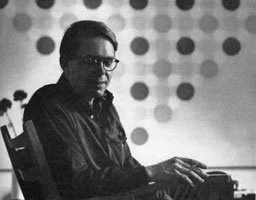THOMAS DOWNING (1928-1985)
Available Work | Biography
Biography • Thomas Downing (1928-1985)
Thomas Downing
Thomas Downing was born in Suffolk, Virginia. In 1950, after graduating from Pratt Institute in New York City, he received a grant from the Virginia Museum of Fine Art to study in Europe. Upon returning from Europe, he settled in Washington, DC to teach at Catholic University. In 1954 Downing became a friend of Kenneth Noland, whose life drawing course he attended. From 1955 to 1956 Downing shared a studio with Howard Mehring, another artist who came to be identified with the Washington Color School. Downing had his first one-man show at the Washington Workshop Center for the Arts in 1959. That year, Downing, Mehring, and Betty Pajac founded Origio, a cooperative art gallery in Washington.
In 1959 Downing first began using the small dot in his work, a motif he explored fully into the 1970s. In the early works colorful dots determined the structure of the painting in their size, position, and repetition within a grid. Often there was a sense of concentration and expansion of the composition from the center to the edge of the canvas, achieving a visual impression of expanding open space. Looking for the fusion between the grid and color, Downing eliminated overlapping dots in 1962. The dots arranged in grids seem to project from the canvas surface, giving the impression the color floats unrestricted by the square format of his paintings.
Downing’s position in the Washington Color School came from his consistent approach to color. The canvas was the receptacle of color, on which Downing often worked in tonal modulations of a hue. Downing developed shaped canvases in 1966 as a structural solution to his deeper consideration of the “spatial definition” of color. After first working in a parallelogram shape, Downing next worked in chevron-shaped canvases that examined the illusionistic qualities of color. He exhibited these works in a solo exhibition at the Corcoran Gallery in 1966-1967 and later at the Allan Stone Gallery in New York in 1967. Downing’s second series of shaped canvases titled Folds were created in 1968. In the Fold series he discovered a new effect of relief and spatial depth within a flat work that could be enhanced by color. The projections and folding in the Fold paintings suggest the paintings exist in a world without gravity.
Downing exhibited in a group show at Jefferson Place Gallery in 1960 and had his first solo exhibition there in the spring of 1961. Downing had solo exhibitions in New York at Allan Stone Gallery in 1962, 1967, and 1968. He also had solo exhibition in New York at Stable Gallery in September 1963 and January 1965. In the early 1970s Downing had regular solo exhibitions at the Pyramid Galleries in DC.
In the 1960s Downing was included in important museum exhibitions, including: Post Painterly Abstraction at Los Angeles County Museum of Art, 1964 (Clement Greenberg curated and included three of Downing’s dial paintings); The Responsive Eye at the Museum of Modern Art, 1965; Colorists, 1950-1965 at the San Francisco Museum of Art, 1965; Systemic Painting at the Solomon R. Guggenheim Museum, New York, 1966; and Color Field Painting at the Philadelphia Museum of Art in 1970. Thomas Downing: Recent Paintings was held at the Corcoran Gallery of Art in December 1966 - January 1967. A solo exhibition of his paintings from 1962 to 1968 was held at the La Jolla Museum of Art then travelled to the Phoenix Art Museum in 1968. Downing had a solo exhibition at the Phillips Collection in 1985.
Downing taught at the Corcoran School of Art and Design, Washington, DC from 1965 to 1968. There he was influential for the next generation of DC color artists including Sam Gilliam. He moved to New York in 1970 and taught at the School of Visual Arts. He then accepted a position at the University of Houston, Texas in 1975. Around 1976, Downing moved to Provincetown where he continued to paint until his death in 1985.
In 2007 Thomas Downing was included in Optic Nerve: Perceptual Art in the 1960s at the Columbus Museum of Art, Ohio and Lyrical Color: Morris Louis, Gene Davis, Kenneth Noland and the Washington Color School at the Phillips Collection, Washington, DC. In 2015, Downing’s painting Five, 1967 was featured in the Whitney Museum’s inaugural exhibition in their new space America is Hard to See.
Downing’s works are in many collections including the Whitney Museum of American Art, New York, NY; the Smithsonian American Art Museum, Washington, DC; the Hirshhorn Museum and Sculpture Garden, Washington, DC; the Phillips Collection, Washington, DC; the Harvard Art Museums, Cambridge, MA; the North Carolina Museum of Art, Raleigh, NC; the Norton Simon Museum, Pasadena, CA; the Oklahoma City Museum of Art, OK; and the Virginia Museum of Fine Arts, Richmond, VA.



